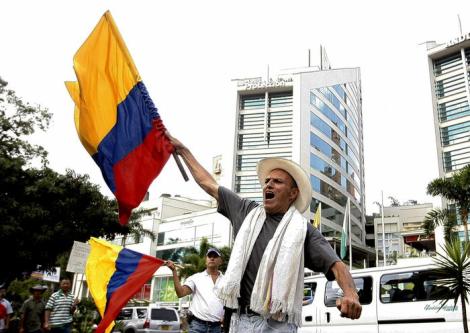From a comfy hotel conference room in Bogata’s swanky business district, Starbuck’s CEO Howard Schultz excitedly states without a hint of irony “I would be disappointed if there weren’t around 50 Stabuck’s in Colombia in the next five year”. The idea seemed akin to Gordon Ramsey instructing Raymond Blanc on how to cook escargot. Why would Starbucks think for a second that Colombia, the country who prides itself on two things (cocaine and coffee), could possibly need mass-produced, faux coffee culture?
The irony was not missed on the Vice-President Craig Russell who more bluntly stated “we want to sell Colombian coffee in Colombia”. In an effort to silence the more cynical critics amongst us, the company combined the plan with an expansion in Colombian coffee purchases by 20%, a more concerted effort in development projects across the country and a promise not to undercut the cooperatively run national Juan Valdez coffee chain. This equals happy farmers, right?
Well, the move comes at a bit of a difficult time for the county’s rural community. Not only is the Colombian government engaging in fragile peace-talks with the countries infamous FARC rebels, but also is also battling an increasingly volatile ten day-long strike which has crippled the nation’s countryside.
With around 200,000 protesting, blocking roads and clashing with police in 11 of the country’s 32 provinces, it has become clear that the issue is not one that will be resolved easily. A Miami Herald report signalled that the vast amount of grievances include “high fuel prices, expensive agrichemicals, government neglect of rural areas and free trade agreements — without adequate safeguards — [which] have made it impossible for farmers to compete”
In a striking condemnation of the right-of-centre Santos administration, the Common Dreams online ‘news centre’ writes that:
“…the Colombian government is handing out sweetheart deals to international mining companies while creating bans and roadblocks for Colombian miners. Likewise, the government is giving multinational food corporations access to land earmarked for poor Colombians. Healthcare workers are fighting a broad range of reforms aimed at gutting and privatizing Colombia’s healthcare system. Truckers are demanding an end to low wages and high gas prices.”
The two dialogues involving FARC rebels and disgruntled farmers are not necessarily unrelated. The story dates back to 2002, when the people elected Alvaro Uribe, a military hardliner whose mandate vowed to eliminate the FARC guerrillas for good. He delivered on his promise, thanks to American financial backing, with his defence secretary Juan Manuel Santos reaping the rewards for his tough-nut stance. Santos was elected in 2010, Colombia was given free-trade agreements with the USA and in the past year, huge strides have been made in disarming the weakened left-wing militants for good.
The problem is that Colombia has been immune to a huge chunk of free-trade agreements in the past. With the introduction of the 2010 policy, the floodgates were opened and the country became susceptible to a rush of American products (80% of them completely untaxed). An Oxfam report suggests that up to 1.8m small-farmers will see wage decreases of around 16% due to increased price competition. With the signing of the treaty, the wonders of free-trade were unleashed. Rather than Colombians drinking traditionally ground, filtered coffee, they can look forward to the finest instant coffee as the plantations fall out of the hands of Colombians.
I’m not the one to hand out abuse of laissez-faire economics, but it is clear that the Uribe/Santos administrations will become synonymous with dramatic changes within the country, not all necessarily good. Free-trade advocates will argue that the removed barriers will see discounted consumer goods enter a market of 45m people and, in exchange, Colombian farmers can sell more of their produce without unhelpful bureaucracy (such as to Starbucks). The problem is that those farmers will have little say in how much they can sell said coffee for. CTPA will produce many winners, but far more losers vis a vis Mexico and NAFTA.
And so, we come back to last night in the central city of Tunja where Colombia’s Agriculture Minister Francisco Estupinan and Interior Minister Fernando Carrillo flew to meet with the people who are currently doing everything to undermine them. Hopes of the road blocks being dismantled and farmers slowly returning to work quickly collapsed. For a lot of the protesters, the strikes are less about subsidising fertilizers or petrol; this would only slow the inevitable impact of globalisation. For these protesters, it is the difference between their humble existence and the complete destruction of their livelihood.
So when Mr Schultz declared jovially this week that Starbucks planned to take the country by force, it couldn’t have been more poorly timed. The company cannot be accused of storming into the country with total disregard for the unstable political situation. Its joint £3m venture with USAID which aims to reduce “extreme poverty, which is still a reality for almost all of these small-scale coffee growers that have barely one hectare (2.5 acres) of land,” will have been a carefully manufactured piece of public relations.
But no one doubts why Starbucks has waited till now, nor why so many other businesses are slowly moving into the country. Colombia has become a safe(r) haven for investment and free-trade only makes it easier. These strikes now represent a final chance for the losers of CTPA to fight back and attempt to halt the often irreversible changes of free-trade.
Until then, Colombians should start learning the phrase “caramel frappacinio with whipped cream, por favor.”



Pingback: 2013: 7 things which have defined Latin America’s year | Watching the Americas·